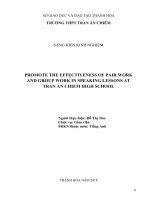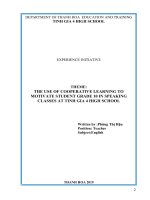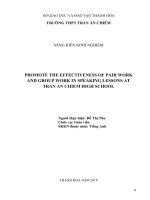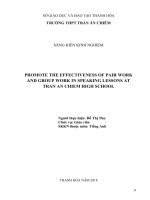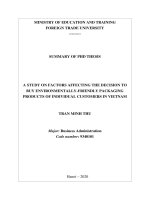A study on factors causing the lack of the grade tenth students’ self confidence in speaking classes at dao duy tu high school
Bạn đang xem bản rút gọn của tài liệu. Xem và tải ngay bản đầy đủ của tài liệu tại đây (900.13 KB, 80 trang )
HONG DUC UNIVERSITY
FACULTY OF FOREIGN LANGUAGES
LUU THI HA
A STUDY ON FACTORS CAUSING THE LACK OF THE
GRADE TENTH STUDENTS’ SELF - CONFIDENCE IN
SPEAKING CLASSES AT DAO DUY TU HIGH SCHOOL
Submitted in partial fulfillment of the requirements of the degree of
Bachelor of Arts in English Language Teacher Education
Thanh Hoa, 2023
HONG DUC UNIVERSITY
FACULTY OF FOREIGN LANGUAGES
LUU THI HA
A STUDY ON FACTORS CAUSING THE LACK OF THE
GRADE TENTH STUDENTS’ SELF - CONFIDENCE IN
SPEAKING CLASSES AT DAO DUY TU HIGH SCHOOL
SUBMITTED IN PARTIAL FULLFILLMENT OF THE REQUIREMENTS
OF THE DEGREE OF BACHELOR OF ARTS IN ENGLISH LANGUAGE
TEACHER EDUCATION
Student’s name: Luu Thi Ha
Student ID No: 1967010045
Supervisor : M.A Trinh Thi Hang
Thanh Hoa, 2023
i
DECLARATION
I sincerely affirm that the minor thesis “A study on factors causing the
grade tenth students’ lack of self-confidence at Dao Duy Tu High School” is
the result of my own work and effort to meet the requirements for graduation
thesis at Faculty of Foreign Languages, Hong Duc University.
Thanh Hoa, May 2, 2023
Luu Thi Ha
ii
ACKNOWLEDGEMENTS
First of all, from the bottom of my heart, I desire to express my deepest
gratitude to my supervisor, M.A Trinh Thi Hang for her valuable advice,
generous assistance and enthusiastic support in completion of this study.
My sincere thanks also go to teachers at Dao Duy Tu High School for
their useful opinions, which have greatly contributed to my work.
I would also like to express my thanks to the grade tenth students at
Dao Duy Tu High School who have actively participated in this study.
I am also in debt of my gratitude to my lecturers and my friends for
their constructive comments and enthusiastic supports.
Last but not least, I wish to convey my appreciation to my family
members due to their whole-hearted encouragement and support.
.
iii
ABSTRACT
The research has been conducted to find out the current state of
students’ self-confidence in speaking classes, factors causing the students’
lack of self-confidence in speaking lessons, and suggest strategies to improve
the learners’ level of self-confidence in oral sessions.
The study was carried out to students at tenth grade at Dao Duy Tu
High School. In this study, classroom observation, interview and
questionnaire were used for collecting the data.
From the analysis of the data, it revealed the factors that lead to
students’ low self-confidence. It is expected that contributions from the study
can be beneficial to the teaching and learning process of English-speaking
skills to grade tenth students in general and grade tenth students at Dao Duy
Tu High School in particular.
iv
TABLE OF CONTENTS
DECLARATION ............................................................................................... i
ACKNOWLEDGEMENTS .............................................................................. ii
ABSTRACT .....................................................................................................iii
TABLE OF CONTENTS ................................................................................. iv
LIST OF TABLES ........................................................................................... vi
LIST OF DIAGRAMS .................................................................................... vii
LIST OF ABBREVIATIONS ......................................................................... vii
PART I: INTRODUCTION .............................................................................. 1
1. Rationale........................................................................................................ 1
2. Aims of the study .......................................................................................... 2
3. Objectives of the study.................................................................................. 2
4. Research questions ........................................................................................ 2
5. Scope of the study ......................................................................................... 3
6. Methods of the study ..................................................................................... 3
7. The significance of the study ........................................................................ 4
8. Design of the study........................................................................................ 4
PART II. DEVELOPMENT ............................................................................. 5
CHAPTER 1. LITERATURE REVIEW .......................................................... 5
1.1. Theoretical background of speaking skills ................................................ 5
1.1.1. Definition of speaking skills ................................................................... 5
1.1.2. The importance of speaking skills .......................................................... 6
1.1.3. Components of speaking ......................................................................... 6
1.1.4. Classroom speaking activities ................................................................. 8
1.2. Self-confidence ........................................................................................ 11
1.2.1 Definition of self-confidence ................................................................. 11
1.2.2. The importance of self-confidence in language learning...................... 12
1.2.3. The influence of self-confidence on learners in speaking lessons........ 13
1.2.4. Lack of self- confidence........................................................................ 14
1.2.5. The characteristics of students with low and high self-confidence ...... 14
1.2.6. Factors causing the lack of self-confidence .......................................... 16
v
1.3. Strategies to improve the students’ lack of self-confidence .................... 18
CHAPTER II. METHODOLOGY AND PROCEDURE ............................... 21
2.1. The setting of the study ............................................................................ 21
2.1.1. An overview of research place.............................................................. 21
2.1.2. English teaching and learning situation at Dao Duy tu High School ... 22
2.1.3. The subjects of the study....................................................................... 22
2.2. Methods of the study ................................................................................ 23
2.2.1. Data collection instruments................................................................... 23
2.2.2. Data collection procedures .................................................................... 23
2.2.3. Methods of data analysis. ...................................................................... 24
CHAPTER III. FINDINGS AND DISCUSSION .......................................... 25
3.1. Findings .................................................................................................... 25
3.1.1. Observation ........................................................................................... 25
3.1.2. Teachers’ interview ............................................................................... 29
3.1.3. Students’ questionnaires ....................................................................... 34
3.2. Discussion ................................................................................................ 43
3.2.1. Current state of students’ self-confidence in speaking lessons............. 43
3.2.2. Factors negatively affecting students’ self-confidence in speaking
classes .............................................................................................................. 44
3.2.3. Suggested strategies to develop students’ self-confidence in oral
sessions............................................................................................................ 46
PART III. CONCLUSION.............................................................................. 57
1.1. Summary of the main ideas...................................................................... 57
1.1.1. Conclusion of the main ideas ................................................................ 57
1.1.2. Summary of the findings ....................................................................... 58
1.2. Limitations of the study ........................................................................... 59
BIBLIOGRAPHY ........................................................................................... 60
APPENDICES .................................................................................................... I
APPENDIX 1 .....................................................................................................I
APPENDIX 2 .................................................................................................. IV
vi
LIST OF TABLES
Table 3.1: Checklist of classroom observation ............................................... 25
Table 3.2. Pupils’ view about factors causing lack of self-confidence in
speaking classes............................................................................................... 34
Table 3.3. Students’ view about how their teachers give feedbacks about their
speaking performance ..................................................................................... 35
Table 3.4. Students’ view about speaking activities that the teacher often use
in oral lessons .................................................................................................. 40
Table 3.5 Students’ view about activities should be frequently used to
enhance their self-confidence.......................................................................... 41
Table 3.6. Teacher’s guidelines of self-directed dialogue technique ............. 48
Table 3.7. Teacher’s guidelines of Discussion technique............................... 51
Table 3.8. Teacher’s guidelines of role-play technique .................................. 53
Table 3.9. Teacher’s guidelines of Debate technique ..................................... 55
vii
LIST OF DIAGRAMS
Chart 3.1. The frequency of students involvement in speaking classes ......... 34
Chart 3.2. Students’ reaction when they cannot think of English words........ 36
Chart 3.3. Students’ opinions about poor grammar can have a negative impact
on self-confidence. .......................................................................................... 36
Chart 3.4. Students’ opinion about good pronunciation can have a positive
effect on self-confidence ................................................................................. 37
Chart 3.5. Students’ view about fear of making mistake can result in the lack
of self-confidence ............................................................................................ 37
Chart 3.6. Students’ view about whether shyness can lead to low self-
confidence in oral lessons or not ..................................................................... 38
Chart 3.7. Students’ opinion about whether motivation has a positive impact
on self-confidence or not................................................................................. 38
Chart 3.8. Students’ feeling when there is little listeners’ support while they
are speaking..................................................................................................... 39
Chart 3.9. Students’ reaction when teachers give negative and disruptive
feedbacks about their speaking performance .................................................. 40
Chart 3.10. Students’ view about group activity which can improve their self-
confidence ....................................................................................................... 42
viii
LIST OF ABBREVIATIONS
M.A: Master of Arts
EFL: English as a Foreign Language
Etc: Etcetera
1
PART I: INTRODUCTION
1. Rationale
English is one dominant language that is learned by millions of people
all over the world. When learning English, students have to master four main
skills: listening, speaking, reading and writing. One of the four skills,
speaking, is considered to be one of the most fundamental language skills.
According to Chastain (2005), speaking “as one important element in
developing each language skill and conveying culture knowledge”.
However, speaking is the skill that makes a lot of students feel worried
and frustrated. Many learners share that they have spent so many years
studying English language but cannot speak it appropriately and
understandably. It has become common that not all students who learn
English are able to speak fluently and confidently. For this reason, many
researchers have conducted studies investigating into contributing factors for
this problem. Various studies have shown that some factors which include
lack of vocabulary, incorrect pronunciation, lack of interest, lack of
motivation, etc have a great impact on low students’ proficiency in verbal
communication. However, to master this productive skill, learners also need
to trust their abilities, which helps them master the language more easily. In
other words, if learners do not have self-confidence, they may not express
their ideas freely and comfortably in spoken language.
“Self-confidence” is the term that has been used by many experts to
describe people who have belief in their capacities. Having self-confidence
can leas us to achievements as self-confidence is the key to be successful in
English speaking skills (Hasan et al., 2020). Moreover, EFL students who
believe in their abilities are able to overcome their fears and negative thoughts
to speak English fluently. Therefore, it can be said that self-confidence plays a
vital role in learning a language in general and speak a language fluently in
particular.
2
In my experience, when I was practicing teaching at Dao Duy Tu High
School, I had many students who were still lacking of self-confidence in
speaking English in front of the class, and from my friends’ experience, they
discovered the same problem as mine. While some students said that they stop
talking because they face psychological obstacles, others claimed that they
cannot find the suitable words and expressions and then being embarrassed.
For the above reasons, I decided to choose the thesis “A study on
factors causing the grade tenth students’ lack of self-confidence at Dao Duy
Tu High School”. This research is conducted to find out the current state of
learners’ self-confidence in oral sessions, factors that cause students' low self-
confidence, and suggest strategies to develop students’ self-confidence in
speaking lessons.
2. Aims of the study
The study aims to figure out what factors might cause the lack of self-
confidence in speaking classes of the tenth grade students, and suggests
strategies to help enhance pupils’ self-confidence.
3. Objectives of the study
The objectives of the study are as following:
(1) To discover the current state of learner’s self-confidence in
speaking lessons
(2) To investigate factors leading to low self-confidence in speaking
lessons
(3) To suggest strategies to improve pupils’ self-confidence in oral
sessions
4. Research questions
The following research questions are conducted to obtain the aim and
objectives mentioned above:
(1) What is the current state of students’ self-confidence in speaking
classes ?
3
(2) What factors lead to students’ low self–confidence in speaking
lessons ?
(3) What strategies should be exploited to improve students’ self-
confidence in speaking classes ?
5. Scope of the study
We focus on factors that cause the lack of self–confidence of grade 10
students’ in speaking classes at Dao Duy Tu high school.
6. Methods of the study
In this study, there were only qualitative methods. The data were
collected from classroom observation, a questionnaire and an interview.
(1) Classroom observation is used to examine the current state of
learners’ self-confidence in speaking lessons. It is a helpful tool to discover
the contexts and can provide more information which can be missing in other
instruments. Since Bell (2005:184) argued that classroom observation can
reveal traits of individuals or groups, thus, it is appropriate to find out some
symptoms of students with low self-confidence
(2) A questionnaire for 100 grade tenth students to identify the current
state of students’ confidence in speaking English, explore factors causing the
lack of self-confidence in speaking lessons and figure out strategies to
improve students’ self- confidence. Questionnaires are designed as a mean to
make the researcher’s evaluation more objective.
(3) An interview in which questions are asked to obtain information.
This is an efficient way to discover people's views, meanings, and definitions
of real situations. The interview was designed to asks teachers to also
discover the current state of students’ self-confidence in oral classes, to find
out factors that lead to students' low - confidence in speaking as well as
strategies to improve the situation of students’ low self-confidence in
speaking lessons. Interviews are the most important tool in qualitative
method.
4
7. The significance of the study
This study can present new knowledge about some typical signs of
students who are low self-confidence in speaking lessons, factors that result in
students' low self-confidence in speaking classes, helping them to be aware of
the factors influencing their self-confidence when speaking. Therefore, pupils
can prepare themselves to speak confidently. The research also suggests some
strategies for teachers to enhance students’ self-confidence in speaking
lessons.
In summary, the research is expected to better both the teaching and
learning speaking skills of grade tenth students in general, the teaching and
learning speaking skills at Dao Duy Tu High School in particular.
8. Design of the study
The study includes three main parts respectively: the introduction,
content of the study and the conclusion
Part I. The introduction provides the basis information such as rationale, aims
of the study, scope of the study, research questions, methods of the study, and
design of the study
Part II. The content of the study consists of 4 chapters:
Chapter 1: Literature review
Chapter 2: Research methodology
Chapter 3: Findings and discussion
Part III. The conclusion is a summary of the study, future directions for future
research and limitations of the study.
5
PART II. DEVELOPMENT
CHAPTER 1. LITERATURE REVIEW
1.1. Theoretical background of speaking skills
1.1.1. Definition of speaking skills
Speaking is a significant skill that every language learners desire
to master. It is believed to be a key area of the development in a native
language and in a foreign language as well, hence, there has been variety of
definitions of speaking skill.
According to Hornby (1995, p.20), speaking is say something
about something, to mention something, to have a conversation with
someone, or express oneself in a specific language.
Thornbury (2005, p.121) states that speaking is an activity carried
out by a speaker to exchange his or her thoughts to interact with listeners,
a collaboration between two or more people in a particular time and context to
express information, or emotions.
Simbolon (2014: 227) also points out that speaking is a productive
skill of a language. The author explains that speaking is generally described
as an activity to convey ideas, thoughts, feelings, emotions of the speaker to
others so that the message can be understood by others.
The most efficient way to communicate is through speech
(Paranduk et al, 2021). Therefore, speaking skill is an essential method of
communication. Clear and confident speaking can attract the attention of
listeners, providing opportunity for the speaker to get the message across.
From the definitions above, we can conclude that speaking is one
of four skills of a foreign language to express the speakers’ opinions, ideas,
thoughts, feelings, etc to other people and plays a vital role in communication.
Without speaking skills, language learners cannot express what they want to
express and it makes them find difficult to communicate with others. So, as a
6
language learner, students have to master this oral skill in order to be able to
communicate well with other people.
1.1.2. The importance of speaking skills
It is no exaggeration to say that without speech, language is like a
movie without characters. Language is used in a variety of situations, for
instance, we speak our language to communicate with colleagues, to talk with
customers, to convey our messages, etc. Or researchers working in a
laboratory or teachers demonstrating lessons to students, are supposed to
speak correctly and effectively in order to communicate well with one another
since any gap in communication can lead to misunderstandings and problems.
The importance of speaking skills, thus, is enormous for any language
learners as Putri, (2008) holds the view that speaking is important as it
conveys information and maintain social relationships.
Moreover, it can be thought that speaking skills offer language
numerous benefits. With the help of speaking skills, they can develop good
relations with other people, they can get job opportunities and many other
things thanks to speaking skills. Moreover, through interaction, they
understand other people clearly. The person with good speaking skills can
have ability to attract the attention of other people, engage others in his or her
conversation and also ensures lucrative careers.
In short, people use language to express thoughts, ideas, etc with other
people. In addition to that, we need to speak efficiently to decrease the
occurrence of misunderstandings and a good language speaker can benefit
from many things such as leaving a good impression on somebody or having
more opportunities in life.
1.1.3. Components of speaking
Students have to know the important components of the speaking skill
in order to be good speakers of the language. Generally, there are four
components of the speaking skill. According to Syakur (1987:5) “speaking is
7
a complex skill because at least it is concerned with components of grammar,
vocabulary, pronunciation, and fluency.
1.1.3.1. Vocabulary
Vocabulary is one of the language components in speaking English.
According to Rivers 1983 (in Nunan, 1991: 117) vocabulary is vital for
successful language use due to the fact that without extensive vocabulary, we
will be unable to convey our ideas to the partners. This means, vocabulary is
the words used by the individuals in order to exchange thoughts with each
other. For English learners, without having a sufficient vocabulary, they
cannot communicate efficiently or express their ideas in both oral and written
forms. Therefore, vocabulary is a great of importance in speaking, and in
order to master a language, students are required to have a wide range of
vocabulary so as to listen, speak, read and write the language well.
1.1.3.2. Pronunciation
Pronunciation is the production of sounds for communication, divided
into three categories: sounds, stress, and intonation. Pronunciation is
substantially important element in mastering the language and speaking it
since a student who mispronounces a word can cause a misunderstanding and
in some cases, may offend other people. Pronunciation has traditionally been
taught with a goal of “speaking like a native speaker” but this is not practical.
In fact, users of the language must know how to pronounce English words and
practice to do so well for others to understand. However, pronunciation is the
aspect of knowledge learners typically do not pay attention to it (Thornbury,
2005). In order to speak English language accurately, learners should master
phonological rules and they should be aware of the various sounds, the stress,
intonation, and pitch. All of these elements help learners speak the English
language more easily and efficiently.
8
1.1.3.3. Grammar
Grammar is the set of rules that show how words are grouped,
arranged, or changed to convey particular meanings (Swan 2005). Someone
who understands grammar will be able to organize words in sentences, use the
right tenses and structures, which can get messages across. As a result,
grammar is also vital in speaking as if we do not know the appropriate
grammar in sentence, the listener will be unsure about what we said. In a
nutshell, having good knowledge of grammar assists learners obtain
proficiency in a language, both in speaking and writing performance.
1.1.3.4. Fluency
A fluent speaker means he or she can use the language smoothly and
confidently, with few pauses, and hesitation, etc (Nunan, 2003:55). It refers to
how well people communicate in natural manner and speaker needs to know
when she/he need to pause or stop his/her speaking in an appropriate place.
Furthermore, it can be said that fluent speaking is when the speaker does not
produce word by word at a time, therefore, in order to be a fluent speaker, he
or she must be able to produce word in groups of words that form a
meaningful clauses.
1.1.4. Classroom speaking activities
Classroom speaking activities play an indispensable role in language
teaching and learning as they help learners practice the real language use and
also enhance their confidence. In reality, there are a wide range of speaking
activities that teachers can implement in the class to help students practice the
target language
a) Information- gap
There are many information gap activities, however, the most popular
one is “Describe and Draw”. According to (Harmer, 1998, p.88), “Describe
and Draw” activity is an ideal techniques in speaking classes since it can
highly motivate students and can be made use of for the purpose of
9
communication. In this activity, one student holds a picture but he or she must
not show it to his or her partner. Thus, the one having the picture will give
descriptions so as to his or her partner ask questions and draw the picture.
b) Story Telling
In this activity, students will tell stories in the target language. The
teacher will inspire students to retell stories they have read in books, in
newspapers, in their daily lives or in the internet. Of course, the best stories
are encouraged to recall are about themselves, their families, or their friends.
c) Favorite Object
It can be done in groups or in pairs. In this activity, students are asked
to speak about their favorite items. Each student is asked to describe the
characteristics of their favorite things and other students try to guess what the
favorite thing is.
d) Meeting and Greeting
This activity is usually taught to beginning language learners. Students
act in a formal meeting in which they meet and present themselves to a group
of people, making an attempt to use meeting and greeting expressions.
e) Describing things or person
Students are expected to provide detailed descriptions of something or
someone to other students. They can speak in front of the class or in groups. It
is similar to describing favorite objects, however, other students do not have
to guess what the object is. Teachers can give pupils items or people, and
students are asked to identify the certain items or people.
f) Discussion
Thoronbury (2005, p.102) views discussion as a significantly beneficial
activity of speaking. This is an activity that involves conversations between
members in the class. The students are divided into various groups then the
instructor assigns a subject for each group to plan. Time is set for pupils to
discuss the given subjects. Finally, a student from each group will present the
10
results of the discussion, the instructor will give some feedbacks on the
students' speaking performance.
g) Debate
This classroom speaking activity can be used for advanced language
learners, such as high school students or university students. Some students
are divided into groups then they are given a subject and time to prepare.
After that, two groups have a debate in front of the class at a set time. Finally,
the teacher will decide the winner and give feedbacks.
h) Describing pictures
Teachers give a picture to different groups of students and ask students
to describe. It may be a single picture or even a strip one, in case the students
can tell a story using the strip picture. Then, they have a certain number of
minutes to talk as many things as possible about the picture.
i) Picture differences
Before using this type of activity, the instructors must find the pictures
which must be almost identical. Students are asked to work in pairs or in
groups to do this activity. Each member of the groups will identify the
differences between the given pictures and then go to the board to talk about
characteristics or differences of them.
k) Role-play
This technique requires students to act as characters in a particular
situation. Teachers can ask them to play a role as a customer buying an item
in a shopping clothes, a guest invited at a party, a guide introducing about a
country’ culture, and so on. Richards and Schmidt (2010) indicated that “in
language teaching drama-like classroom activities in which students take the
roles of different participants in a situation and act out what might typically
happen in that situation”. The role-play activity gives learners an opportunity
to practice the target language, allows them to express comfortably, creatively
and confidently.

